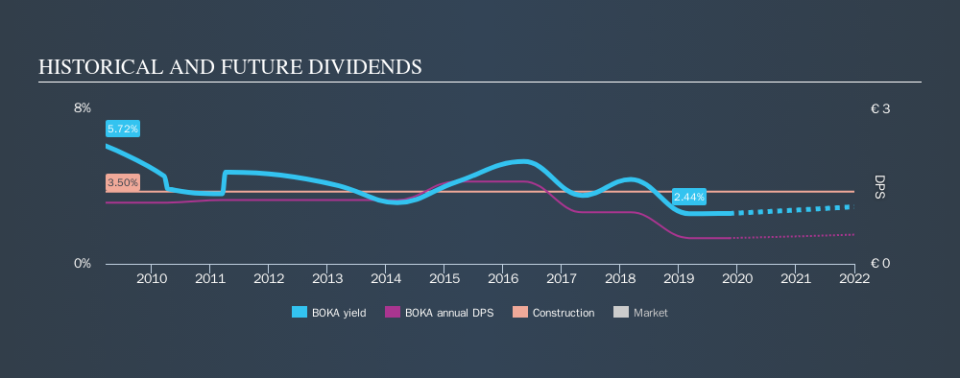Are Dividend Investors Making A Mistake With Royal Boskalis Westminster N.V. (AMS:BOKA)?

Today we'll take a closer look at Royal Boskalis Westminster N.V. (AMS:BOKA) from a dividend investor's perspective. Owning a strong business and reinvesting the dividends is widely seen as an attractive way of growing your wealth. If you are hoping to live on your dividends, it's important to be more stringent with your investments than the average punter. Regular readers know we like to apply the same approach to each dividend stock, and we hope you'll find our analysis useful.
A slim 2.4% yield is hard to get excited about, but the long payment history is respectable. At the right price, or with strong growth opportunities, Royal Boskalis Westminster could have potential. Some simple analysis can reduce the risk of holding Royal Boskalis Westminster for its dividend, and we'll focus on the most important aspects below.
Explore this interactive chart for our latest analysis on Royal Boskalis Westminster!
Payout ratios
Dividends are usually paid out of company earnings. If a company is paying more than it earns, then the dividend might become unsustainable - hardly an ideal situation. As a result, we should always investigate whether a company can afford its dividend, measured as a percentage of a company's net income after tax. Although it reported a loss over the past 12 months, Royal Boskalis Westminster currently pays a dividend. When a company is loss-making, we next need to check to see if its cash flows can support the dividend.
Last year, Royal Boskalis Westminster paid a dividend while reporting negative free cash flow. While there may be an explanation, we think this behaviour is generally not sustainable.
Consider getting our latest analysis on Royal Boskalis Westminster's financial position here.
Dividend Volatility
Before buying a stock for its income, we want to see if the dividends have been stable in the past, and if the company has a track record of maintaining its dividend. For the purpose of this article, we only scrutinise the last decade of Royal Boskalis Westminster's dividend payments. Its dividend payments have fallen by 20% or more on at least one occasion over the past ten years. During the past ten-year period, the first annual payment was €1.19 in 2009, compared to €0.50 last year. This works out to be a decline of approximately 8.3% per year over that time. Royal Boskalis Westminster's dividend hasn't shrunk linearly at 8.3% per annum, but the CAGR is a useful estimate of the historical rate of change.
A shrinking dividend over a ten-year period is not ideal, and we'd be concerned about investing in a dividend stock that lacks a solid record of growing dividends per share.
Dividend Growth Potential
With a relatively unstable dividend, and a poor history of shrinking dividends, it's even more important to see if EPS are growing. Royal Boskalis Westminster's earnings per share have shrunk at 54% a year over the past five years. A sharp decline in earnings per share is not great from from a dividend perspective, as even conservative payout ratios can come under pressure if earnings fall far enough.
Conclusion
When we look at a dividend stock, we need to form a judgement on whether the dividend will grow, if the company is able to maintain it in a wide range of economic circumstances, and if the dividend payout is sustainable. Royal Boskalis Westminster's dividend is not well covered by free cash flow, plus it paid a dividend while being unprofitable. Earnings per share are down, and Royal Boskalis Westminster's dividend has been cut at least once in the past, which is disappointing. There are a few too many issues for us to get comfortable with Royal Boskalis Westminster from a dividend perspective. Businesses can change, but we would struggle to identify why an investor should rely on this stock for their income.
Given that earnings are not growing, the dividend does not look nearly so attractive. Businesses can change though, and we think it would make sense to see what analysts are forecasting for the company.
If you are a dividend investor, you might also want to look at our curated list of dividend stocks yielding above 3%.
We aim to bring you long-term focused research analysis driven by fundamental data. Note that our analysis may not factor in the latest price-sensitive company announcements or qualitative material.
If you spot an error that warrants correction, please contact the editor at editorial-team@simplywallst.com. This article by Simply Wall St is general in nature. It does not constitute a recommendation to buy or sell any stock, and does not take account of your objectives, or your financial situation. Simply Wall St has no position in the stocks mentioned. Thank you for reading.

 Yahoo Finance
Yahoo Finance 
